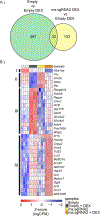CRISPR-Cas9-induced IGF1 gene activation as a tool for enhancing muscle differentiation via multiple isoform expression
- PMID: 31914652
- PMCID: PMC6956731
- DOI: 10.1096/fj.201901107RR
CRISPR-Cas9-induced IGF1 gene activation as a tool for enhancing muscle differentiation via multiple isoform expression
Abstract
Muscle wasting, or muscle atrophy, can occur with age, injury, and disease; it affects the quality of life and complicates treatment. Insulin-like growth factor 1 (IGF1) is a key positive regulator of muscle mass. The IGF1/Igf1 gene encodes multiple protein isoforms that differ in tissue expression, potency, and function, particularly in cellular proliferation and differentiation, as well as in systemic versus localized signaling. Genome engineering is a novel strategy for increasing gene expression and has the potential to recapitulate the diverse biology seen in IGF1 signaling through the overexpression of multiple IGF1 isoforms. Using a CRISPR-Cas9 gene activation approach, we showed that the expression of multiple IGF1 or Igf1 mRNA variants can be increased in human and mouse skeletal muscle myoblast cell lines using a single-guide RNA (sgRNA). We found increased IGF1 protein levels in the cell culture media and increased cellular phosphorylation of AKT1, the main effector of IGF1 signaling. We also showed that the expression of Class 1 or Class 2 mRNA variants can be selectively increased by changing the sgRNA target location. The expression of multiple IGF1 or Igf1 mRNA transcript variants in human and mouse skeletal muscle myoblasts promoted myotube differentiation and prevented dexamethasone-induced atrophy in myotubes in vitro. Our findings suggest that this novel approach for enhancing IGF1 signaling has potential therapeutic applications for treating skeletal muscle atrophy.
Keywords: gene regulation; insulin‐like growth factor 1; muscle atrophy.
© 2019 Federation of American Societies for Experimental Biology.
Conflict of interest statement
COMPETING INTERESTS:
Authors declare no conflicts of interests.
Figures





References
-
- Jackman RW, and Kandarian SC (2004) The molecular basis of skeletal muscle atrophy. Am J Physiol Cell Physiol 287, C834–843 - PubMed
-
- Lecker SH, Jagoe RT, Gilbert A, Gomes M, Baracos V, Bailey J, Price SR, Mitch WE, and Goldberg AL (2004) Multiple types of skeletal muscle atrophy involve a common program of changes in gene expression. FASEB J 18, 39–51 - PubMed
-
- Lok C. (2015) Cachexia: The last illness. Nature 528, 182–183 - PubMed
Publication types
MeSH terms
Substances
Grants and funding
LinkOut - more resources
Full Text Sources
Research Materials
Miscellaneous

